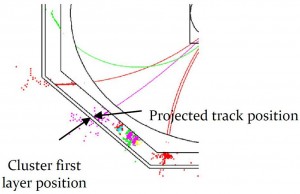When particles collide, they often produce sprays of new particles called jets. Given the complexity of these particles’ interactions, measuring the energy of jets with high precision is a formidable challenge. New detector designs, such as those being developed for the ILC and CLIC, are based on a paradigm called particle flow which will allow physicists to identify and measure each particle within a jet using the subdetector which provides the best measurement.
To understand how particle flow works, you need to think about the way particles move through a detector’s subcomponents. A given jet may include about twenty particles, many of which will carry a charge. The detector’s tracker will capture the momentum of the charged particles and the calorimeters will measure the energy of both charged and neutral particles. The energy of a jet is then reconstructed by adding the momenta of the charged particles, as measured by the tracker, and the energies of the neutral particles, as measured with the calorimeter. This provides the best energy resolution.
Particle flow requires that scientists correctly identify the energy deposits in the calorimeter as originating from either charged or neutral particles. To do this, they must match the charged particles observed in the tracker to energy deposits in the calorimeter. Energy deposits without a match come from neutral particles.
The concept may sound simple but in practice it requires pushing calorimeters further than ever before. The calorimeters must be finely segmented in order to provide more resolution, resulting in tens of millions of channels and an image-like level of detail. “This is a really novel endeavor,” says Argonne scientist José Repond. “Only recent developments in electronics have made this possible.” Repond and colleagues recently created a one cubic meter prototype of a hadron calorimeter, compatible in design with the detectors planned for the ILC or CLIC, that had 500 thousand channels, more than the total number of channels on all four calorimeters at the Large Hadron Collider combined.
Read more about particle flow.


Recent Comments